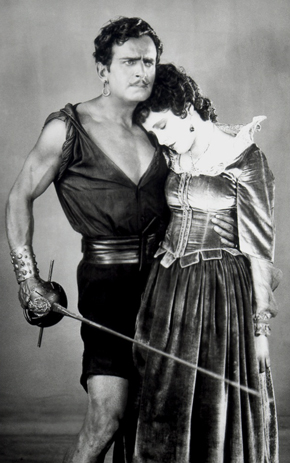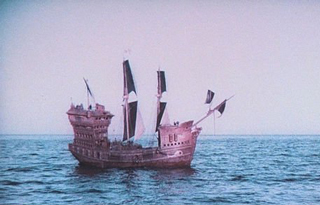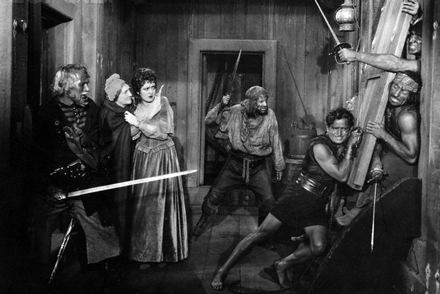
 |
|
|
|
Viewers that believe the swashbuckling adventure genre began with Errol Flynn will get a big kick out of Douglas Fairbanks' silent extravaganza The Black Pirate, which plays out the same sub-Sabatini tall tales in similar high spirits. Kino International's new Blu-ray presents this elaborate production in its original two-strip Technicolor hues. The extras include interesting outtakes and an entire modified "talkie" version released when sound came in. 
Douglas Fairbanks was undeniably one of the most famous entertainers alive. Douglas, his movie star wife Mary Pickford and close associate Charlie Chaplin were superstars that earned astronomical sums in pre-income tax, high-value dollars. Fairbanks charmed millions with his bright smile & optimistic outlook and he exploited his athleticism in films that featured impressive action stunts. Sets were built to the specific dimensions of the actor's abilities -- when his Robin Hood or Thief of Baghdad needed to leap between two buildings, the gap was constructed just close enough for him to comfortably jump. The Black Pirate has the prerequisite swashbuckling swordfights and action scenes as well as its share of interesting special effects. The story is an escapist fantasy through and through. A band of pirates captures a cargo ship, slaughtering every man aboard save for Michel, the Duke of Arnoldo (Fairbanks). Michel swims to a nearby desert island where the pirate chief lands to stash his ill-gotten plunder. Michel walks into their midst, puts on a cheery, self-confident act, and defeats the pirate king in a swordfight. He then continues his bluff and takes command, assuming the role of the dreaded "Black Pirate". Michel uses trickery instead of violence to seize the next cargo ship without a fight, and proposes that the crew split up to sail the boat to a port where it can be sold. But the pirates seize the lovely Isobel (Billie Dove) and play a dice game to see who will earn the right to "ravage" her. Michel delays this fate-worse-than-death by pretending that Isobel is a princess and therefore too valuable as an object for ransom. Further developments find a squadron of underwater swimmers retaking the ship to help Michel rescue Isobel once again. Most of us first became aware of The Black Pirate in Kevin Brownlow's 1979 docu miniseries about silent cinema, in excerpts that showed Douglas Fairbanks' carefree pirate sliding the full length of a billowing sail, slicing it in two as he descends. This is actually how "pirate" Michel captures his first ship, disabling the mainsails and slowing it for capture. The stunt ends in high style with Michel swinging gracefully up to perch on a yard (filmed in reverse). Brownlow chose this particular gag for its sophistication, as Fairbanks didn't "free slide" down the sails but instead simply clung to a knife attached to a rig on the back of the sail. The moment also begs comparison with Errol Flynn, whose forest entrance in The Adventures of Robin Hood is a similar nonchalant rope swing, up into a forest tree. 
Flynn's later pirate epics (there were really only three) made use of enormous interior sets that could accommodate two ship mock-ups, as well as dozens of actor-stunt men willing to perform dangerous-looking mass action scenes (one wonders if they ever found, at the end of the shooting day, a spare extra at the bottom of the studio tank). The Black Pirate's action takes place mostly on the real ocean, in broad daylight. While not as spectacular, Fairbanks' fights are certainly elaborate. Making the strongest impression is a number of gruesome details of pirate etiquette. Captured seamen are routinely slaughtered. In one early scene, a quaking prisoner tied to a mast swallows a valuable ring rather than have it stolen. But his effort doesn't escape notice: a pirate draws his knife, walks off-screen, and returns in a few moments with the recovered (and bloody) ring. And we thought that sadistic movie humor began with James Bond! After all this carnage, Fairbanks makes a glorious entrance, striding up to a band of cutthroats as if taking a refreshing walk in the park. Michel is a master swordsman but survives by stringing the crew along in a full-on con job, promising higher profits while managing to keep the terrified Isobel out of the hands of the scurvy first mate. In for light comedy and unofficial mascot duty is Donald Crisp. He plays MacTavish, a salty Scots pirate who likes Michel's brand of Kinder, Gentler piracy. The inter-title writer works overtime to insert the right flavor into MacTavish's text dialogue. It's hard to say if director Albert Parker really called the shots or was just there to shout "Action" and "Cut". Fairbanks surrounded himself with idea men and advisors (including fencing masters) but reserved all final decisions to himself. The movie has more than its share of arresting images. In a distant pre-echo of Thunderball, we see a screen-full of pirates swimming underwater, weapons in their teeth, sneaking from ship to ship. They're really hanging by wires on a dry stage, but the effect is very amusing. A triumphant Michel remains in medium close-up as he's hoisted from the ship's hold to the upper decks by dozens of cheering pirates. The escapist daydream aspect of the story is topped off when the victorious Michel is received in port by a grateful monarch -- and discovers that Isobel was a real princess all along! She gets a manly husband, and he gets a beautiful wife and a fabulous treasure. Except for a few dead pirates, everybody lives happily ever after. 
In 1926 two-strip Technicolor was an exotic novelty, even though the range of hues seems limited to odd earth tones, dull greens and orange-y faces. The effect is similar to ancient two-tone magazine illustrations, or to printed photographs where certain color dyes have disappeared due to fading. The extra light needed for the process probably indicated shooting in bright sunlight where possible. I don't know if giant arc lights were needed to provide fill light at this time, but when 3-strip came around, the banks of focused lights made actors feel like guinea pigs in an oven. Seen today, this primitive Technicolor almost resembles a half-hearted attempt at colorization, until one pays closer attention and sees how the designers work to arrange the colors of objects in the set. And the ruddy, suntanned Douglas Fairbanks even looks healthier in color. Kino International's Blu-ray of The Black Pirate presents the film in mostly fine condition, with a vibrant picture throughout. Only once or twice does a moment of B&W footage show through, presumably where the Technicolor elements were damaged. Kino's HD presentation is fully stocked. Viewers have a choice of the original 1926 orchestral score or an organ score by Lee Erwin. The capable critic and historian Rudy Behlmer provides an extremely informative commentary. The second "talkie" version shows how popular silent films were reworked for early sound presentation. Voiceovers replace inter-titles, telling the story and adding dialogue wherever it fits, not necessarily when people are talking. The synchronized sound effects apparently impressed audiences of the time. Without the inter-titles the film is substantially shorter; this second version is not in color. 
In addition to a photo gallery, the presentation contains two groups of original daily outtakes. A first batch carries commentary by Rudy Behlmer and shows alternate versions of scenes as well as a full set of dailies on the famous sail-slicing stunt. A second, larger group of outtakes comes from the Library of Congress. With its HD presentations of Metropolis and three Buster Keaton movies, Kino is going boldly where big studios fear to tread, providing Blu-rays of bona fide film treasures and not just new releases (who cares about those?). The Black Pirate is an eye-opening reminder that silent movies can be just as exciting as anything made later -- and more original.
On a scale of Excellent, Good, Fair, and Poor,
The Black Pirate Blu-ray rates:
Reviews on the Savant main site have additional credits information and are often updated and annotated with reader input and graphics. Also, don't forget the 2010 Savant Wish List. T'was Ever Thus.
Review Staff | About DVD Talk | Newsletter Subscribe | Join DVD Talk Forum |
| ||||||||||||||||||